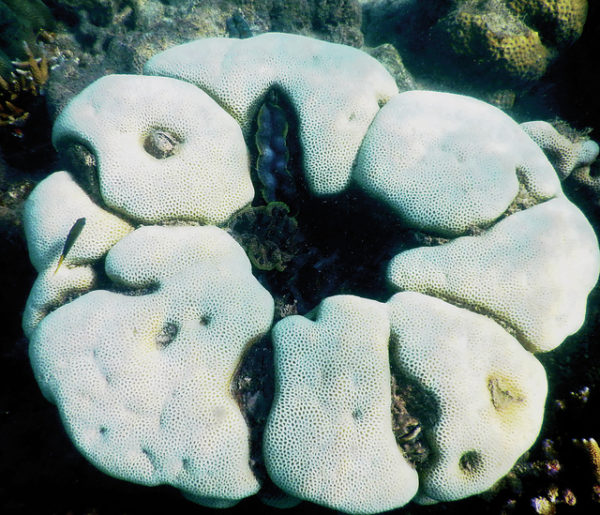Published in the Ocean Watch column, Honolulu Star-Advertiser © Susan Scott
October 29, 2016
Whitsunday Islands, Australia >> Among these famous islands, fish of every color, shape and size swim among corals of every color, shape and size. And squeezed into virtually every nook and cranny of these underwater gardens are sponges, clams, seaweed and countless other plants and animals.
Floating above this riot of life on a calm sunny day makes me feel totally at peace. But the creatures below me aren’t at peace. They live in a constant state of war.
 A coral micro atoll is formed due to encroachment by several species of clams.
A coral micro atoll is formed due to encroachment by several species of clams.
©2016 Susan Scott.
As with nearly all living organisms on Earth, the fighting is about territory. Millions of offspring of thousands of species must settle down where they can get food, mature and make babies. But space in clear shallow water is mostly taken, making competition fierce.
Stony corals often hold prime spots, and are under constant attack by other coral species trying to get a foothold. Corals, however, can fight. Some use long stinging tentacles that sweep surrounding areas to kill early settlers. Others use guerrilla warfare at night, extending filaments that digest their new neighbors’ soft bodies.
While hard corals defend themselves with strings and strands, soft corals use chemical weapons called terpenoids to hold their borders. Some soft corals are particularly aggressive, growing right over hard corals and smothering them.
One bay here consists nearly entirely of such single-minded softies, mostly rubber and leather corals that are flexible to the touch. Between them are other soft corals, some with fluttering tentacles resembling dust mops and palm fronds. Others look like spilled pancake batter, lace doilies and pink pansies, all swaying in the current.
The pretty pastels and slow movements are so serene, it’s hard to remember that these creatures have knocked off an entire bay of stony corals to live there.
Stony corals are also under constant assault from noncoral organisms. Christmas tree worms, clams, sponges and snails set up housekeeping on hard corals. Starfish, butterflyfish and parrotfish eat them, and seaweeds grow over them.
As much as stony polyps fight back, the colony gradually loses ground over time and becomes what’s called a micro atoll. The original coral species struggles around the edges, but a mixed community thrives in its center. Eventually, a new species dominates, becomes king of the hill, and the cycle starts all over again.
Such winning and losing of space creates the diversity we see on coral reefs as well as on the entire planet.
Recalling that fighting for territory is a natural part of life on Earth helps me cope. Perhaps the end result of human warring will be something as beautiful as the Great Barrier Reef.